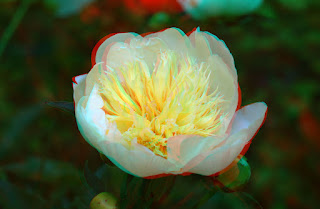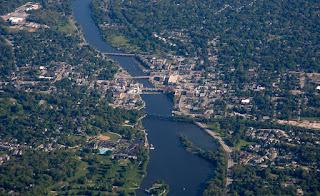
 Here be anaglyphs!
Here be anaglyphs!A day or two after we arrived, the iris patch adjacent to our house started blooming. Unfortunately, a heavy rain hit a day later and knocked them all to the ground, so no iris images... Fortunately, a few days after that our neighbor Elaine's peony bushes started blooming, so have some flower pictures to post. She has a nice collection of various hybrids with an astounding range of features... I thought I've posted about them before, but darned if I can find them in any searches... In my opinion, one of the most spectacular are these that almost look like tulips, with a large white bowl with a tangle of snake-like structures in the center. I thought that the 3D anaglyphs showed it off the best, so here is a wide shot at left, and one of just the center at right.

 Another variety is a 2-tone striking blossom with a pale yellow center, with outer wreath of pale lavender. Then, while understated, there is a pure white one sort of like the tulip outer structure above, but with a shredded white interior. Again, 3D anaglyphs work best in showing these shapes, if not the colors. Sometimes the colors are affected by the red/blue filters in the glasses. The effect doesn't seem too bad for these, but does affect the yellow center in the flowers above...
Another variety is a 2-tone striking blossom with a pale yellow center, with outer wreath of pale lavender. Then, while understated, there is a pure white one sort of like the tulip outer structure above, but with a shredded white interior. Again, 3D anaglyphs work best in showing these shapes, if not the colors. Sometimes the colors are affected by the red/blue filters in the glasses. The effect doesn't seem too bad for these, but does affect the yellow center in the flowers above...Ok, enough of the 3D for this post - STEREO MODE - OFF!

 Finally one of the last striking peonies of Elaine's collection is a light purple or dark lavender, with an interior of the yellow serpent-like structures of the tulip-shaped version above. Sorry I don't know the names for these varieties, but looking at the thousands of Google images, I'm not unconvinced there may be hundreds if not thousands of varieties! We have a small patch we planted a few years ago, but not sure what variety it is. The picture at right shows the current state - still a ball, with some ants feeding on the nectar leaking out of the bud... Hopefully it will bloom before we take off to remember what kind we have! BTW, the image at right is a 5-frame focus stack with the macro to make sure all the details are in focus...
Finally one of the last striking peonies of Elaine's collection is a light purple or dark lavender, with an interior of the yellow serpent-like structures of the tulip-shaped version above. Sorry I don't know the names for these varieties, but looking at the thousands of Google images, I'm not unconvinced there may be hundreds if not thousands of varieties! We have a small patch we planted a few years ago, but not sure what variety it is. The picture at right shows the current state - still a ball, with some ants feeding on the nectar leaking out of the bud... Hopefully it will bloom before we take off to remember what kind we have! BTW, the image at right is a 5-frame focus stack with the macro to make sure all the details are in focus...
 We made another trip to Iowa on Sunday - I guess it must be a tradition! We had a dinner/pool party at brother Jim's house in DeWitt. It is a great gathering place - besides the pool and what would be called a lanai or lounge area in some places, their entire basement is a "party room" with full kitchen, TV room and large meet and greet area. Sister-in-law Karen came on RAGBRAI with us one year, and gave us a great surprise by inviting our buddy Carl to drive in from Cedar Rapids! What a nice shock to see him walking up. Besides our 20-year RAGBRAI history, he and Melinda are buddies on the Facebook, so we both spent some quality time with him. As he left, we took the snapshot at left - itself a test of the 6D. The TV room is a dark place and here the camera's ISO is set to 25,600, and this shot is a 125th of a second at F/5. This is also a significant crop, so a little noise and sharpness loss is visible in the full-size image shown here, but not too bad...
We made another trip to Iowa on Sunday - I guess it must be a tradition! We had a dinner/pool party at brother Jim's house in DeWitt. It is a great gathering place - besides the pool and what would be called a lanai or lounge area in some places, their entire basement is a "party room" with full kitchen, TV room and large meet and greet area. Sister-in-law Karen came on RAGBRAI with us one year, and gave us a great surprise by inviting our buddy Carl to drive in from Cedar Rapids! What a nice shock to see him walking up. Besides our 20-year RAGBRAI history, he and Melinda are buddies on the Facebook, so we both spent some quality time with him. As he left, we took the snapshot at left - itself a test of the 6D. The TV room is a dark place and here the camera's ISO is set to 25,600, and this shot is a 125th of a second at F/5. This is also a significant crop, so a little noise and sharpness loss is visible in the full-size image shown here, but not too bad... I spent a little time with niece Sandy and their 16-month-old Natalie. Now when Jeff (Sandy's husband) and his siblings were small, whenever a camera appeared, they went into "performance" mode - always a quick, easy smile, and easy to pose and photograph. While with mom at right she was more interested in eating her snack, at right you can see the start of her "performance" mode teethy grin! Perhaps she hasn't finalized "the look", but she is on her way!
I spent a little time with niece Sandy and their 16-month-old Natalie. Now when Jeff (Sandy's husband) and his siblings were small, whenever a camera appeared, they went into "performance" mode - always a quick, easy smile, and easy to pose and photograph. While with mom at right she was more interested in eating her snack, at right you can see the start of her "performance" mode teethy grin! Perhaps she hasn't finalized "the look", but she is on her way!
 And I've been just hanging around taking the occasional photograph around the house too. I saw a shot across the river from us when we first arrived, but needs a dead-calm river, which we haven't had much of lately. Shown at left is a line of colored chairs that caught my eye. The morning was calm, but not quite calm enough - still some water movement. The 105mm kit lens (the longest lens I've got along) doesn't make it large enough, especially for the full-size sensor of the 6D, but I did what I could.
And I've been just hanging around taking the occasional photograph around the house too. I saw a shot across the river from us when we first arrived, but needs a dead-calm river, which we haven't had much of lately. Shown at left is a line of colored chairs that caught my eye. The morning was calm, but not quite calm enough - still some water movement. The 105mm kit lens (the longest lens I've got along) doesn't make it large enough, especially for the full-size sensor of the 6D, but I did what I could.Another of my activities here is my daily (sometimes twice daily!) bike rides on the recumbent. It has been really nice to get out every day for some physical activity. I still look at the recumbent as a little dodgy in traffic - tough to start from a stop, and with the upright position, I can't see behind me well. So mostly I go to the local Riverbend Park and take advantage of a mile-or-so path around the periphery. No motorized traffic, and only a few dog-walkers and other bikers to watch out for. Anyway, coming up the hill around a little pond with the curve of the path leading to the horizon, I thought it might make a nice picture, and indeed, I like it! So that is the reason for the image at right. The fence at left is a dog run, the fence at left is a small skate park, and I think you can see the small pavilion for all-weather events and playground equipment at center too. A nice, all-purpose place to spend some time...





















































